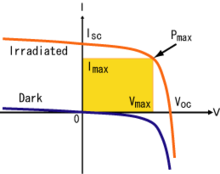- Maximum power point tracking
-
Maximum power point tracking (MPPT) is a technique that grid tie inverters, solar battery chargers and similar devices use to get the maximum possible power from the PV array.[1] Solar cells have a complex relationship between solar irradiation, temperature and total resistance that produces a non-linear output efficiency known as the I-V curve. It is the purpose of the MPPT system to sample the output of the cells and apply a resistance (load) to obtain maximum power for any given environmental conditions.[2] Essentially, this defines the current that the inverter should draw from the PV in order to get the maximum possible power (since power equals voltage times current).
Contents
I-V curve
Photovoltaic cells have a complex relationship between their operating environment and the maximum power they can produce. The fill factor, more commonly known by its abbreviation FF, is a parameter which characterizes the non-linear electrical behavior of the solar cell. Fill factor is defined as the ratio of the maximum power from the solar cell to the product of Voc and Isc, and in tabulated data it is often used to estimate the power that a cell can provide with an optimal load under given conditions, P=FF*Voc*Isc. For most purposes, FF, Voc, and Isc are enough information to give a useful approximate model of the electrical behavior of a photovoltaic cell under typical conditions.
For any given set of operational conditions, cells usually have a single operating point where the values of the current (I) and Voltage (V) of the cell result in a maximum power output. These values correspond to a particular load resistance, which is equal to V/I as specified by Ohm's Law. The power P is given by P=V*I. A photovoltaic cell has an approximately exponential relationship between current and voltage (taking all the device physics into account, the model can become substantially more complicated though). As is well known from basic circuit theory, the power delivered from or to a device is optimized where the derivative (graphically, the slope) dI/dV of the I-V curve is equal and opposite the I/V ratio (where dP/dV=0). This is known as the maximum power point (MPP) and corresponds to the "knee" of the curve.
A load with resistance R=V/I equal to the reciprocal of this value is the load which draws maximum power from the device, and this is sometimes called the characteristic resistance of the cell. Note however that this is a dynamic quantity which changes depending on the level of illumination, as well as other factors such as temperature and the age of the cell. If the resistance is lower or higher than this value, the power drawn will be less than the maximum available, and thus the cell will not be used as efficiently as it could be. Maximum power point trackers utilize different types of control circuit or logic to search for this point and thus to allow the converter circuit to extract the maximum power available from a cell.
Classification
There are three main types of MPPT algorithms: perturb-and-observe, incremental conductance and constant voltage.[3] The first two methods are often referred to as hill climbing methods, because they depend on the fact that on the left side of the MPP, the curve is rising (dP/dV > 0) while on the right side of the MPP the curve is falling (dP/dV < 0).[4]
Perturb-and-observe (P&O) method
Main article: Perturb and observe methodThis method is the most common. The algorithm perturbs the operating voltage in a given direction and samples dP/dV. If dP/dV is positive, then the algorithm knows it adjusted the voltage in the direction toward the MPP. It keeps adjusting the voltage in that direction until dP/dV is negative.
P&O algorithms are easy to implement, but they sometimes result in oscillations around the MPP in steady-state operation. They also have slow response times and can even track in the wrong direction under rapidly changing atmospheric conditions.
Incremental conductance (INC) method
Main article: Incremental conductance methodThis method uses the PV array's incremental conductance dI/dV to compute the sign of dP/dV. INC tracks rapidly changing irradiance conditions more accurately than the P&O method. However, like the P&O method, it can produce oscillations and be confused by rapidly changing atmospheric conditions. Another disadvantage is that its increased complexity increases computational time and slows down the sampling frequency.
Constant voltage method
This method makes use of the fact that the ratio of maximum power point voltage to the open circuit voltage is often close to a constant value, with 0.76 being a common estimate. One problem with this method arises from the fact that it requires momentarily setting the PV array current to 0 to measure the array's open circuit voltage. The array's operating voltage is then set to (for example) 76% of this measured value. But during the time the array is disconnected, the available energy is wasted. It has also been found that while 76% of the open circuit voltage is often a very good approximation, it does not always coincide with the maximum power point.[5] Thus this method may not give as much efficiency as others, especially if conditions are highly variable or the physical behavior of the cell deviates from expectations. Its main advantage is that it is relatively simple to implement and thus usually less expensive.
MPPT placement
Traditional solar inverters perform MPPT for an entire array as a whole. In such systems the same current, dictated by the inverter, flows through all panels in the string. But because different panels have different IV curves, i.e. different MPPs (due to manufacturing tolerance, partial shading, etc.) this architecture means some panels will be performing below their MPP, resulting in the loss of energy.[6]
Some companies (see power optimizer) are now placing peak power point converters into individual panels, allowing each to operate at peak efficiency despite uneven shading, soiling or electrical mismatch.
Operation with batteries
At night, an off-grid PV power system uses batteries to supply its loads. Although the battery pack voltage when fully charged may be close to the PV array's peak power point, this is unlikely to be true at sunrise when the battery is partially discharged. Charging may begin at a voltage considerably below the array peak power point, and a MPPT can resolve this mismatch.
When the batteries in an off-grid system are full and PV production exceeds local loads, a MPPT can no longer operate the array at its peak power point as the excess power has nowhere to go. The MPPT must then shift the array operating point away from the peak power point until production exactly matches demand. (An alternative approach commonly used in spacecraft is to divert surplus PV power into a resistive load, allowing the array to operate continuously at its peak power point.)
In a grid-tied photovoltaic system, the grid is essentially a battery with near infinite capacity. The grid can always absorb surplus PV power, and it can cover shortfalls in PV production (e.g., at night). Batteries are thus needed only for protection from grid outages. The MPPT in a grid tied PV system will always operate the array at its peak power point unless the grid fails when the batteries are full and there are insufficient local loads. It would then have to back the array away from its peak power point as in the off-grid case (which it has temporarily become).
MPPT as a motor drive
See also: Solar pumpMPPTs can be designed to drive an electric motor without a storage battery. They provide significant advantages, especially when starting a motor under load. This can require a starting current that is well above the short-circuit rating of the PV panel. A MPPT can step the panel's relatively high voltage and low current down to the low voltage and high current needed to start the motor. Once the motor is running and its current requirements have dropped, the MPPT will automatically increase the voltage to normal. In this application, the MPPT can be seen as an electrical analogue to the transmission in a car; the low gears provide extra torque to the wheels until the car is up to speed.
References
- ^ "Invert your thinking: Squeezing more power out of your solar panels". scientificamerican.com. http://www.scientificamerican.com/blog/post.cfm?id=invert-your-thinking-squeezing-more-2009-08-26. Retrieved 2011-06-09.
- ^ "MAXIMUM POWER POINT TRACKING". qwiki.com. http://www.qwiki.com/q/#!/Maximum_power_point_tracking. Retrieved 2011-06-10.
- ^ "Evaluation of Micro Controller Based Maximum Power Point Tracking Methods Using dSPACE Platform". itee.uq.edu.au. http://itee.uq.edu.au/~aupec/aupec06/htdocs/content/pdf/165.pdf. Retrieved 2011-06-14.
- ^ Comparative Study of Maximum Power Point Tracking Algorithms. doi:10.1002/pip.459.
- ^ "MPPT ALGORITHMS". powerelectronics.com. http://powerelectronics.com/power_semiconductors/power_microinverters_computercontrolled_improve_0409/. Retrieved 2011-06-10.
- ^ "Invert your thinking: Squeezing more power out of your solar panels". Scientific American. 2009-08-28. http://www.scientificamerican.com/blog/post.cfm?id=invert-your-thinking-squeezing-more-2009-08-26. Retrieved 2009-10-10.
External links
- "Solarfreaks forum". http://solarfreaks.com. Retrieved 2007-05-11.
DIY MPPT projects
- Arduino PPT solar charger (Arduino based)
- MPPT tracker by Daniel F. Butay (Microchip PIC based)
Photovoltaics Concepts - Photoelectric effect
- Photovoltaics
- History of photovoltaics
- Timeline of solar cells
- Solar insolation
- Solar constant
- Solar cell efficiency
- Third generation photovoltaic cell
- Solar cell research
- Quantum efficiency of a solar cell
- Cadmium telluride
- Thermophotovoltaic
- Polycrystalline silicon photovoltaics
- Thermodynamic efficiency limit
- Sun-free photovoltaics
- Polarizing organic photovoltaics

Photovoltaic system Solar cells- Solar cell
- Solar panel
- Thin film solar cell
- Polymer solar cell
- Nanocrystal solar cell
- Organic solar cell
- Quantum dot solar cell
- Hybrid solar cell
- Plasmonic solar cell
- Carbon nanotubes in photovoltaics
- Dye-sensitized solar cell
- Cadmium telluride photovoltaics
- Copper indium gallium selenide solar cells
- Multijunction photovoltaic cell
- Printed solar panel
System components- Solar charge controller
- Solar inverter
- Solar micro-inverter
- Solar cable
- Solar combiner box
- Photovoltaic mounting system
- Maximum power point tracker
- Solar tracker
- Solar shingles
- Solar mirror
System concepts- Perturb and observe method
- Incremental conductance method
- Constant voltage method
- Fill factor
- Concentrated photovoltaics
- Photovoltaic thermal hybrid solar collector
- Space-based solar power
- Watt-peak
Applications Appliances- Solar-powered refrigerator
- Solar air conditioning
- Solar lamp
- Solar charger
- Solar backpack
- Solar tree
- Solar-powered pump
- Solar-powered watch
- Solar Tuki
- Photovoltaic keyboard
- Solar road stud
- Solar cell phone charger
- Solar notebook
- Solar powered calculator
- Solar powered fountain
- Solar powered radio
- Solar powered flashlight
- Solar fan
- Solar street light
- Solar traffic light
Land transport- Solar vehicle
- Solar car
- Solar roadway
- Solar golf cart
- The Quiet Achiever
- Sunmobile
Air transport- Electric aircraft
- Mauro Solar Riser
- Solar panels on spacecraft
- Solar-Powered Aircraft Developments Solar One
- Gossamer Penguin
- Qinetiq Zephyr
- Solar Challenger
Water transportSolar vehicle racing- Solar car racing
- List of solar car teams
- Solar challenge
- Solar Cup
- Blue Sky Solar Racing
- Frisian Solar Challenge
- UC Solar Team
- Solar Splash
- South African Solar Challenge
- Tour de Sol
- World Solar Challenge
- Hunt-Winston School Solar Car Challenge
- North American Solar Challenge
- Victorian Model Solar Vehicle Challenge
Generation systems - Solar Energy Generating Systems
- Stand-alone photovoltaic power system
- Grid-connected photovoltaic power system
- Rooftop photovoltaic power station
- Topaz Solar Farm
- Solar Ark
- Solar Umbrella house
- Erlasee Solar Park
- Guadarranque solar power plant
- Pocking Solar Park
- Copper Mountain Solar Facility
- Wyandot Solar Facility
- Köthen Solar Park
- Building-integrated photovoltaics
- Moura Photovoltaic Power Station
- Nevada Solar One
- Beneixama photovoltaic power plant
- Gottelborn Solar Park
- Darro Solar Park
- Olmedilla Photovoltaic Park
- Blythe Photovoltaic Power Plant
- Strasskirchen Solar Park
- Puertollano Photovoltaic Park
- Alamosa photovoltaic power plant
By countryList of countries by photovoltaics productionPV companies  Category ·
Category ·  CommonsCategories:
CommonsCategories:- Electric power systems components
- Solar power
- Photovoltaics
Wikimedia Foundation. 2010.


